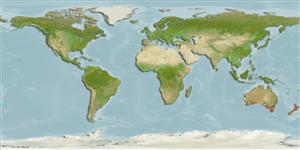>
Scombriformes (Mackerels) >
Arripidae (Australian salmon)
Etymology: Arripis: Latin, arripio, arripere = to take something suddenly.
More on author: Forster.
Environment: milieu / climate zone / rango de profundidad / distribution range
Ecología
marino; salobre pelagic-neritic; anadromo (Ref. 51243); rango de profundidad 30 - 39 m (Ref. 58489). Subtropical; 27°S - 47°S, 112°E - 176°W
Southwest Pacific: southern Australia (including Tasmania, Lord Howe Island and Norfolk Island), usually Brisbane to Western Victoria, rarely to Western Australia; and New Zealand (including Chatham and Kermadec Islands).
Length at first maturity / Tamaño / Peso / Age
Madurez: Lm 32.5, range 29 - 36 cm
Max length : 89.0 cm TL macho / no sexado; (Ref. 27296); common length : 47.0 cm TL macho / no sexado; (Ref. 9258); peso máximo publicado: 9.4 kg (Ref. 9988); edad máxima reportada: 26 años (Ref. 9072)
Short description
Claves de identificación | Morfología | Morfometría
Espinas dorsales (total) : 9; Radios blandos dorsales (total) : 15 - 17; Espinas anales: 3; Radios blandos anales: 9 - 10; Vértebra: 25. Adults are dark blue-green above and silvery below, with irregularly defined spots arranged laterally in indistinct rows (Ref. 33616). Length of upper lobe of caudal fin < 29.9% SL, more or less equal to, or less than, the length fo the head (Ref. 9701).
Body shape (shape guide): fusiform / normal; Cross section: compressed.
Inhabit continental shelf waters including estuaries, bays and inlets (Ref. 6390). Found between depths of 30 m (Ref. 33616) and 39 m (Ref. 58489). They enter rivers (Ref. 9002). Juveniles form school in shallow coastal bays and estuaries; adults move in large schools along shores (Ref. 9002), and can move over reefs in depths just sufficient to cover their bodies (Ref. 6390). They form large surface aggregations in deep water (Ref. 6390). Feed mainly on fishes but also on pelagic crustaceans, especially krill (Nyctiphanes australis). Take also food from the seabed. Fish smaller than 10 cm feed predominantly on copepods (Ref. 9072). Utilized fresh, canned and frozen; can be steamed, fried, broiled, boiled, microwaved and baked (Ref. 9988).
Eastern Australian salmon are probably serial batch spawners (Ref. 27961).
Paulin, C., 1993. Review of the Australian fish Family Arripididae (Percomorpha), with the description of a new species. Aust. J. Mar. Freshwat. Res. 44(3):459-471. (Ref. 9701)
IUCN Red List Status (Ref. 130435: Version 2025-1)
Threat to humans
Harmless
Human uses
Pesquerías: comercial; pesca deportiva: si; carnada: usually
Herramientas
Special reports
Download XML
Fuentes de Internet
Estimates based on models
Preferred temperature (Referencia
123201): 15.6 - 22.3, mean 17.4 °C (based on 14 cells).
Phylogenetic diversity index (Referencia
82804): PD
50 = 0.6250 [Uniqueness, from 0.5 = low to 2.0 = high].
Bayesian length-weight: a=0.00955 (0.00349 - 0.02613), b=3.01 (2.78 - 3.24), in cm total length, based on LWR estimates for this (Sub)family-body shape (Ref.
93245).
Nivel trófico (Referencia
69278): 4.1 ±0.6 se; based on diet studies.
Generation time: 4.1 (3.3 - 7.9) years. Estimated as median ln(3)/K based on 11
growth studies.
Resiliencia (Referencia
120179): Medio, población duplicada en un tiempo mínimo de 1.4-4.4 años (K=0.2-0.3; tm=4).
Prior r = 0.39, 95% CL = 0.26 - 0.59, Based on 2 full stock assessments.
Fishing Vulnerability (Ref.
59153): Moderate vulnerability (37 of 100).
🛈
Climate Vulnerability (Ref.
125649): Very high vulnerability (100 of 100).
🛈
Nutrients (Ref.
124155): Calcium = 52.1 [34.3, 88.4] mg/100g; Iron = 1.2 [0.8, 1.8] mg/100g; Protein = 20.7 [18.4, 22.6] %; Omega3 = 0.365 [0.227, 0.591] g/100g; Selenium = 19.2 [11.0, 32.9] μg/100g; VitaminA = 13.8 [5.4, 36.4] μg/100g; Zinc = 0.672 [0.506, 0.912] mg/100g (wet weight); based on
nutrient studies.
